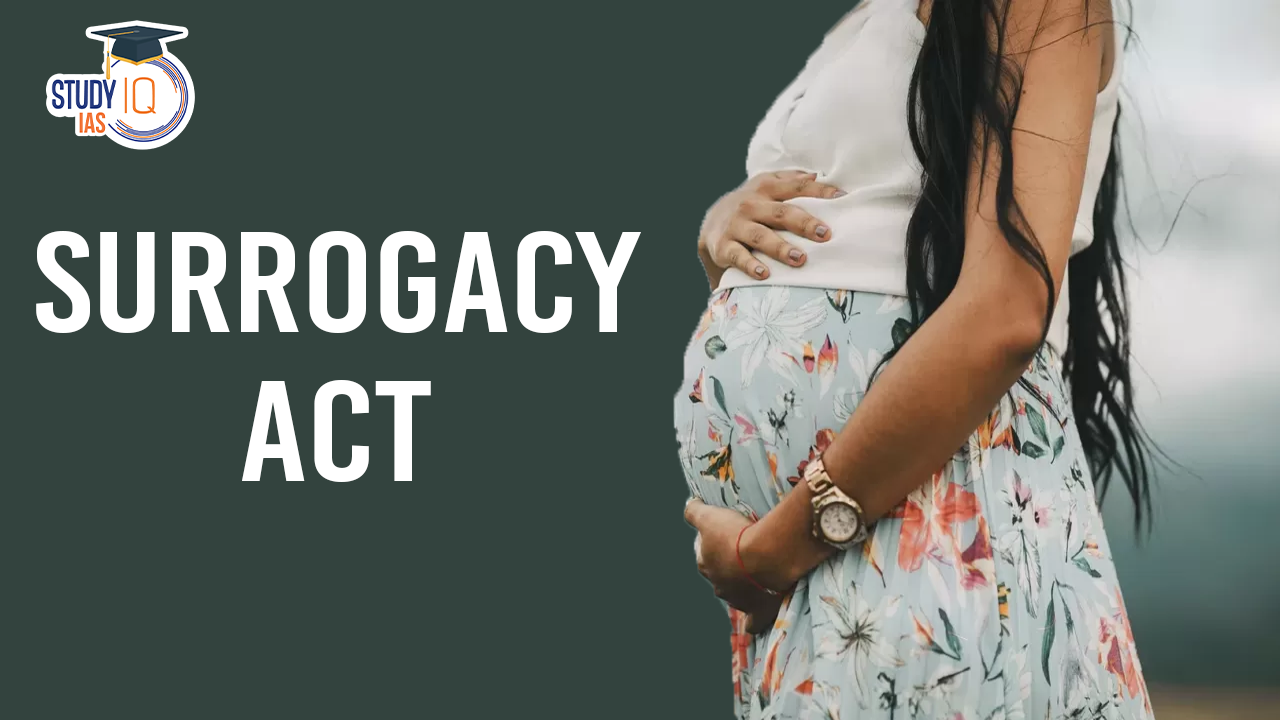Table of Contents
The Surrogacy (Regulation) Act, 2021 and the Assisted Reproductive Technologies (Regulation) Act, 2021 have raised various concerns, particularly regarding the constitutional validity of some provisions such as overpayment prohibition, and transitioning to altruistic surrogacy.
What is Surrogacy?
Surrogacy is an arrangement where a woman, called the surrogate mother, agrees to carry and give birth to a baby for another person or couple, referred to as the intended parents.
Types of Surrogacy
- Traditional Surrogacy: The surrogate’s egg is fertilised by the intended father’s sperm.
- The surrogate carries the pregnancy, and the baby is genetically related to both the surrogate mother and the intended father.
- Gestational Surrogacy: The surrogate carries an embryo created from the intended parents’ or donors’ sperm and egg.
- The baby is not genetically related to the surrogate mother.
Surrogacy Arrangements
- Altruistic Surrogacy: The surrogate mother does not receive financial payment beyond covering medical and pregnancy-related expenses.
- The main motive is usually to help the intended parents fulfil their wish of having a child.
- Commercial Surrogacy: The surrogate mother receives financial compensation in addition to the reimbursement of medical and pregnancy-related costs.
- The compensation amount can vary based on location, legal regulations, and the specifics of the agreement.
Surrogacy Regulations in India
- Permissibility: The Surrogacy (Regulation) Act 2021 allows surrogacy only for altruistic purposes.
- It is permitted for couples with proven infertility or disease.
- Commercial surrogacy is banned.
- The Surrogacy Act prohibits “buying or trading the services” of surrogate mothers, meaning no payment or reward is allowed apart from covering medical expenses and providing insurance.
- Eligibility Requirements for Couples: Couples must be married for a minimum of 5 years.
- The wife’s age should be between 25-50 years and the husband’s age between 26-55 years.
- The couple should not have any living child, whether biological, adopted, or from previous surrogacy, except in cases of children with disabilities or life-threatening conditions.
- Criteria for Surrogate Mothers: The surrogate must be a close relative of the intended parents.
- She must be married and have at least one child of her own.
- Her age should be between 25-35 years, and she can only be a surrogate once in her life.
- Parental Status at Birth: The child born through surrogacy is legally recognized as the biological child of the intended parents.
- Any abortion of the foetus requires consent from both the surrogate mother and relevant authorities, according to the Medical Termination of Pregnancy Act.
| Recently in News |
About Recent Amendment
|
What are the Challenges Associated with Surrogacy in India?
- Exclusion of LGBTQIA+ Community: The Surrogacy Regulation Act of 2021 excludes LGBTQIA+ couples from accessing altruistic surrogacy, raising concerns of discrimination and inequality.
- Exclusion of Live-In Relationships: The Act also excludes live-in partners from surrogacy arrangements, despite Indian courts recognizing and protecting live-in relationships.
- Social Stigma: Due to the societal stigma around assisted reproduction, surrogates in India are often forced to carry the pregnancy in secrecy, endure poor physical conditions, and receive compensation that is only about a third of what the practice would cost in developed nations.
- Balancing Child’s Rights and Surrogate Exploitation: While the state should protect the child’s right to birth, it must also prevent the exploitation of impoverished women through surrogacy. The Act fails to adequately balance these two critical concerns.
- Impact on Women’s Reproductive Freedom: The Act infringes on women’s fundamental reproductive rights, as protected under Article 21 of the Indian Constitution, by reinforcing patriarchal norms that undervalue women’s physical labour.
- Prohibition of Commercial Surrogacy: The ban on commercial surrogacy reduces the number of willing surrogates and denies them a legal source of income.
- It also limits options for couples who wish to have children through surrogacy.
- Emotional Challenges: Altruistic surrogacy involving a friend or relative can lead to emotional complications for the intended parents and the surrogate child.
- The relationship may face strain during and after the surrogacy process.
- Absence of a Third Party in Altruistic Surrogacy: Without third-party involvement in altruistic surrogacy, the intended parents bear full responsibility for covering all medical and additional costs.
- This process is usually facilitated by intermediaries in commercial surrogacy, making communication and coordination easier, which may not be the case in altruistic surrogacy.
- Exclusion of Disabled Couples: Surrogacy laws also exclude disabled couples, further restricting access to parenthood for a vulnerable group that faces additional challenges in the reproductive process.
Supreme Court Judgements on Surrogacy
- Baby Manji Yamada case (2008): In this case, a Japanese couple had a child through a surrogate mother in India.
- However, they got divorced before the child’s birth, and there were issues regarding the child’s citizenship and travel documents.
- The Supreme Court held that the intended parents were the legal parents of the child, and ordered the Indian government to issue a travel document for the child.
- Jan Balaz case (2014): In this case, a German couple had twins through a surrogate mother in India.
- However, one of the twins had Down Syndrome, and the couple refused to take him back to Germany.
- The Supreme Court held that the intended parents had to take both children back to Germany, and that the surrogate mother had no parental rights over the children.
- 2017 ban on commercial surrogacy: In 2017, the Supreme Court of India banned commercial surrogacy in the country, except for cases where the surrogate mother is a close relative of the intending parents.
- The court cited concerns over the exploitation of women and the commodification of children.
- Shilpa Shetty case (2021): In this case, actress Shilpa Shetty and her husband were accused of illegally obtaining a child through surrogacy. The couple denied the allegations, and the case is still ongoing.
Way Forward
- Allowing Reasonable Compensation: It should be regulated by regulatory bodies, not based on bargaining power as recommended by the 102nd Report of the Rajya Sabha’s Department-related Parliamentary Standing Committee.
- Compensation should cover lost wages, medical screening, psychological counselling, dietary supplements, and post-delivery care.
- Inclusive Access to Surrogacy for LGBTQIA+ Community: Amend the Surrogacy Act to include LGBTQIA+ couples in the definition of eligible commissioning parents, ensuring equal access to surrogacy services.
- Example: India should follow these inclusive policies in light of the Navtej Singh Johar v. Union of India judgement, which decriminalised homosexuality and affirmed LGBTQIA+ rights.
- Inclusion of Live-In Partners: Expand the Act to include live-in couples who wish to become parents via surrogacy, in line with the evolving legal recognition of live-in relationships.
- Example: The Khushboo v. Kanniammal case validated live-in relationships under Article 21 (right to life), which should extend to their right to parenthood through surrogacy, aligning with modern societal norms.
- Reducing Social Stigma: Create awareness campaigns to reduce the stigma around assisted reproduction.
- Public health programs can provide education about surrogacy and its importance for individuals who are unable to conceive naturally.
- Balancing Child’s Rights and Preventing Exploitation: Strengthen regulatory frameworks to protect surrogate mothers from exploitation while ensuring the child’s right to birth.
- Reaffirming Women’s Reproductive Freedom: Review the Act to safeguard women’s reproductive rights and eliminate patriarchal biases that devalue women’s physical labour.
- Addressing Emotional Challenges in Altruistic Surrogacy: Establish counselling services for both intended parents and surrogates to address the potential emotional complexities in altruistic surrogacy.


 AI and its Regulation in India, Limitati...
AI and its Regulation in India, Limitati...
 Tuberculosis (TB), Symptoms, Causes and ...
Tuberculosis (TB), Symptoms, Causes and ...
 Silicon Photonics Enables Low-power AI A...
Silicon Photonics Enables Low-power AI A...





















